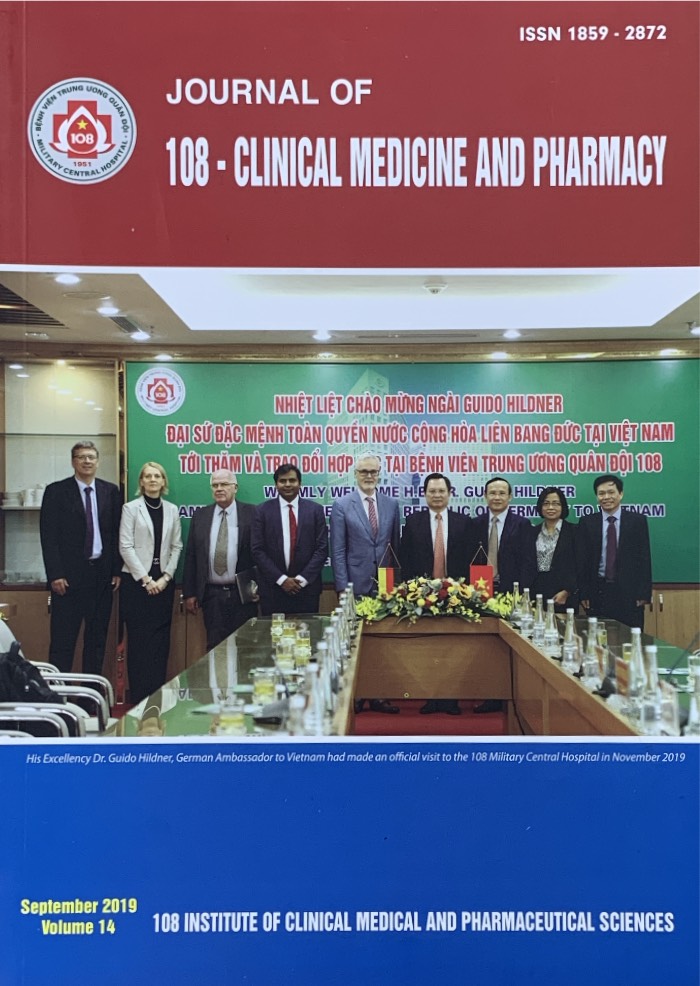A comparison of different diagnostic criteria of acute kidney injury in cardiac surgery patients
Main Article Content
Abstract
Objective: To compare of three diagnostic criteria of acute kidney injury (AKI), included KDIGO, RIFLE and AKIN, for patients with cardiac surgery. Subject and method: A descriptive study on 247 patients underwent cardiac surgery with cardiopulmonary bypass in the 108 Military Central Hospital from January 2015 to September 2017. Serum creatinine (sCr) was measured at the following times: Arrival in ICU (T0), 12 hours (T1), 24 hours (T2), and 48 hours (T3) after to evaluate the incidence and severity of AKI according to three criteria (KDIGO, RIFLE and AKIN). Result: The incidence of AKI was 48.5% based on KDIGO, higher than that of RIFLE (39.6%) and AKIN (46.9%). The severity of AKI according to KDIGO I, II, III was 67.3%, 24.4% and 8.1% respectively; RIFLE R, I, F was 67.3%, 24.5%, and 8.1%; and AKIN I, II, III was 76.7%, 16.3% and 6.9% respectively. AKI patients had higher mortality (7.5% vs. 1.57%) and longer ICU and post-operative stays than non-AKI ones. Conclusion: KDIGO had better sensitivity for detect AKI than RIFLE and AKIN. AKI led to higher mortality, longer ICU and hospital stays after surgery.
Keywords: Acute kidney injury, cardiac surgery, diagnostic criteria.
Article Details
References
2. Chertow GM, Lazarus JM, Christiansen CL et al (1997) Preoperative renal risk stratification. Circulation 95: 878-884.
3. Englberger L, Suri RM, Connolly HM et al (2013) Increased risk of acute kidney injury in patients undergoing tricuspid valve surgery. Eur J Cardiothorac Surg 43(5): 993-999.
4. Howitt SH, Grant SW, Caiado C et al (2018) The KDIGO acute kidney injury guidelines for cardiac surgery patients in critical care: A validation study. BMC Nephrol 19(1): 149.
5. Kidney Disease: Improving Global Outcomes (KDIGO) Acute Kidney Injury Work Group (2012) KDIGO clinical practice guideline for acute kidney Injury. Kidney International Supplements 2(1): 1-126.
6. Loef BG, Epema AH, Smilde TD et al (2005) Immediate postoperative renal function deterioration in cardiac surgical patients predicts in-hospital mortality and long-term survival. J Am Soc Nephrol 16: 195-200.
7. Luo X, Jiang L, Du B et al (2014) A comparison of different diagnostic criteria of acute kidney injury in critically ill patients. Crit Care 18(4): 144.
8. Machado MN, Nakazone MA, Maia LN (2014) Prognostic value of acute kidney injury after cardiac surgery according to kidney disease: Improving global outcomes definition and staging (KDIGO) criteria. PLoS One 9(5): 98028.
9. Mehta RL, Kellum JA, Shah SV et al (2007) Acute Kidney Injury Network: Report of an initiative to improve outcomes in acute kidney injury. Crit Care 11(2): 31.
10. Xiong J, Tang X, Hu ZJ et al (2015) The RIFLE versus AKIN classification for incidence and mortality of acute kidney injury in critical ill patients: A meta-analysis. Scientific Reports 5: 17917.
 ISSN: 1859 - 2872
ISSN: 1859 - 2872
